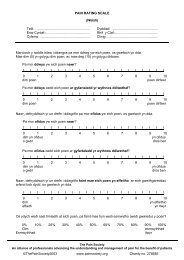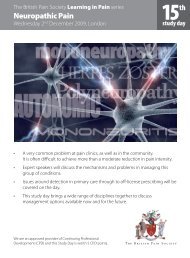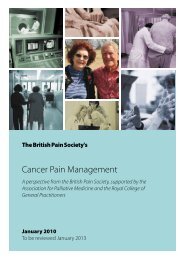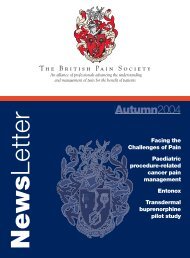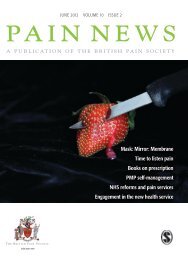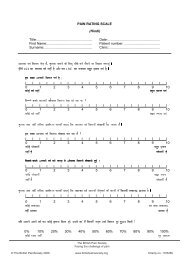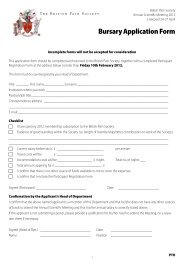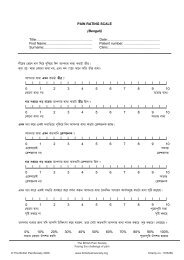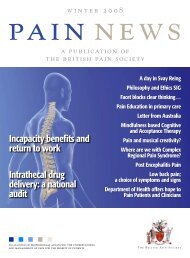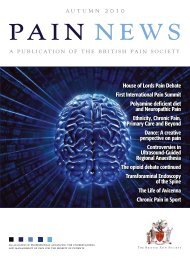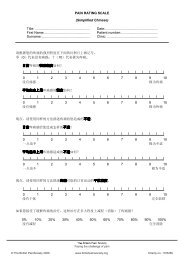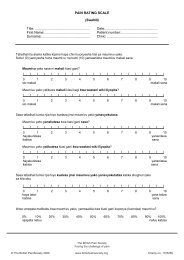Summer 2010 - The British Pain Society
Summer 2010 - The British Pain Society
Summer 2010 - The British Pain Society
Create successful ePaper yourself
Turn your PDF publications into a flip-book with our unique Google optimized e-Paper software.
PAIN SHORTCUTS (CONTINUED)<br />
for more than 28 days before entry<br />
into the study and remained on<br />
the same medications and doses<br />
throughout the study. Subjects had<br />
not had ketamine before.<br />
Appropriate exclusion criteria<br />
were applied and the subjects<br />
randomised to either the ketamine<br />
or the placebo group.<br />
<strong>The</strong> subjects received a full<br />
neurological examination and<br />
pain evaluation at the start of the<br />
study. <strong>The</strong> subjects were asked<br />
to complete a short form McGill<br />
questionnaire, quality of life<br />
questionnaire and a seven question<br />
pain questionnaire weekly until the<br />
start of the infusions.<br />
<strong>The</strong> subjects all wore an activity<br />
watch for at least 2 weeks prior to<br />
treatment and 2 weeks following<br />
treatment. <strong>The</strong> subjects underwent<br />
sensory and motor tests 2 weeks<br />
prior to treatment and at 1 and 3<br />
months post treatment.<br />
On all 10 infusion days the subjects<br />
were monitored for cardiac<br />
rhythm, blood pressure, pulse<br />
and oxygen saturation. Subjects<br />
were given Clonidine 0.1mg orally<br />
and midazolam 2mg IV prior to<br />
the infusion and 2mg IV following<br />
the 4 hour infusion. All subjects<br />
were infused with 100ml normal<br />
saline with or without ketamine<br />
for 4 hours daily for 10 days ( 5<br />
days on, 2 days off, 5 days on)<strong>The</strong><br />
maximum ketamine infusion rate<br />
was 0.35mg/kg/h, not to exceed<br />
25mg/hr. On the first day the IV<br />
ketamine infusion was set to 50%<br />
of the max rate, 75% max rate on<br />
the second day and maximum rate<br />
on the third day and maintained<br />
at maximum rate for the duration<br />
on the study. Following the<br />
last infusion the subjects were<br />
reviewed at 2 weeks and then<br />
monthly for 3 months. <strong>The</strong>y were<br />
asked to wear the activity watch<br />
from the last infusion until the 2<br />
week post infusion visit and were<br />
asked to complete the short form<br />
McGill, quality of life and pain<br />
questionnaires weekly until the end<br />
of the study 3 months after the last<br />
infusion.<br />
<strong>The</strong> study was stopped at the<br />
halfway point because an interim<br />
analysis was conducted which<br />
showed there was little placebo<br />
effect .This meant that statistical<br />
significance could be reached in<br />
many of the study parameters with<br />
a smaller number of study subjects<br />
than was originally anticipated. Also<br />
further experience with outpatient<br />
ketamine infusions showed that<br />
50mg/hr provided much greater<br />
pain relief for a greater period of<br />
time.<br />
10 subjects were in the placebo<br />
group and 9 subjects in the<br />
ketamine group. <strong>The</strong> study<br />
showed a significant reduction<br />
in pain (p




